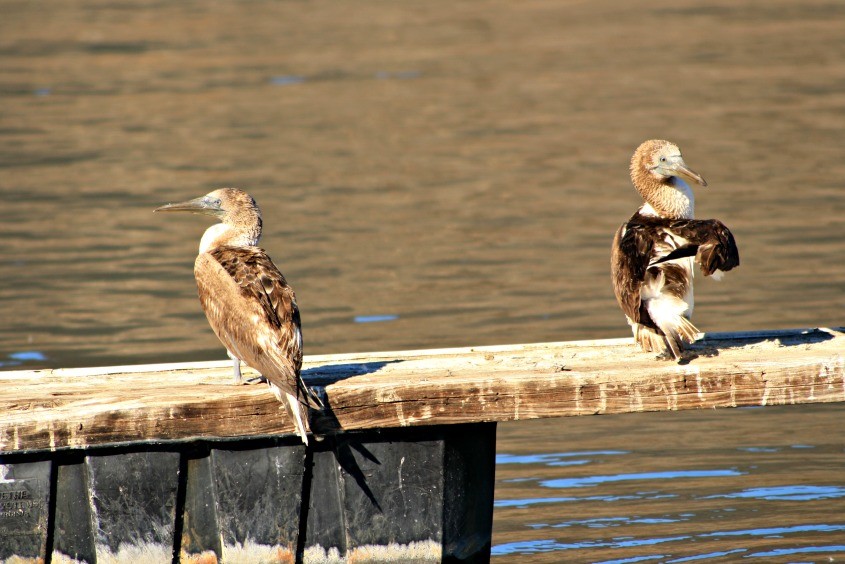Blue-footed Booby
A species of Boobies Scientific name : Sula nebouxii Genus : Boobies
Blue-footed Booby, A species of Boobies
Botanical name: Sula nebouxii
Genus: Boobies
Content
Description People often ask General Info
 Photo By chdwckvnstrsslhm , used under CC-BY-SA-2.0 /Cropped and compressed from original
Photo By chdwckvnstrsslhm , used under CC-BY-SA-2.0 /Cropped and compressed from original Description
The blue-footed booby is on average 81 cm (32 in) long and weighs 1.5 kg (3.3 lb), with the female being slightly larger than the male. Its wings are long, pointed, and brown in color. The neck and head of the blue-footed booby are light brown with white streaks, while the belly and underside exhibit pure white plumage. Its eyes are placed on either side of its bill and oriented towards the front, enabling excellent binocular vision. Its eyes are a distinctive yellow, with the male having more yellow in its irises than the female. Blue-footed booby chicks have black beaks and feet and are clad in a layer of soft white down. The subspecies S. n. excisa that breeds on the Galápagos Islands is larger than the nominate subspecies and has lighter plumage especially around the neck and head. The Peruvian booby is similar in appearance, but has grey feet, whiter head and neck, and white spots on its wing coverts. The ranges of the two species overlap in the waters of northern Peru and southern Ecuador. Since the blue-footed booby preys on fish by diving headlong into the water, its nostrils are permanently closed, and it has to breathe through the corners of its mouth. Its most notable characteristic is its blue-colored feet, which can range in color from a pale turquoise to a deep aquamarine. Males and younger birds have lighter feet than females. Its blue feet play a key role in courtship rituals and breeding, with the male visually displaying his feet to attract mates during the breeding season. 
Size
81 cm (32 in)
Life Expectancy
17 years
Nest Placement
Ground
Clutch Size
1 - 3 eggs
Feeding Habits
Blue-footed Booby predominantly consume fish, including anchovies, sardines, mackerel, and flying fish, with some squid. They exhibit sexually dimorphic foraging, with larger females diving deeper for bigger fish. Blue-footed Booby plunge-dive from up to 100 ft, reaching 82 ft underwater, often in groups that dive synchronously. Prey is mainly caught during daylight, typically in shallow to moderate depths, and eaten underwater, with solo consumption post-hunt.
Habitat
Blue-footed Booby's habitat spans warm, coastal regions of the eastern Pacific, often in arid, rocky islands with limited vegetation, from sea level to moderate elevations. Predominantly found from California to the Galápagos Islands and south to Peru, they nest in large colonies on bare lava flats and prefer to roost on stable shore structures rather than pelagic waters or vessels.
Nest Behavior
The parents take turns incubating eggs and caring for the young, with egg-laying and nesting activities synchronized with food availability.
Nest Characteristics
Blue-footed Booby's nest is a simple, bowl-shaped scrape on flat sandy or rocky coastal areas, often ringed with guano.
Dite type
Piscivorous
People often ask
General Info
Feeding Habits
Bird food type
Behavior
Blue-footed Booby engage in a captivating courtship involving vivid foot displays and synchronized movements designed to attract mates, reflecting their complex social interactions. In daily life, blue-footed Booby meticulously defend their territory, alternating between foraging at sea and incubating eggs on land. It’s common for them to indulge in striking dive-bomb feeding techniques, along with underwater pursuits powered by their wings, demonstrating their adaptation to the marine environment. Notably, blue-footed Booby display a unique strategy by laying eggs several days apart, which leads to size differences among chicks, thus influencing their competitive sibling behavior.
Distribution Area
The blue-footed booby is distributed among the continental coasts of the eastern Pacific Ocean from California to the Galápagos Islands south into Peru. It is strictly a marine bird. Its only need for land is to breed and rear young, which it does along the rocky coasts of the eastern Pacific. A booby may use and defend two or three nesting sites, which consist of bare black lava in small divots in the ground, until they develop a preference for one a few weeks before the eggs are laid. These nests are created as parts of large colonies. While nesting, the female turns to face the sun throughout the day, so the nest is surrounded by excrement. 
Species Status
Not globally threatened.
Scientific Classification
Phylum
Chordates Class
Birds Order
Gannets and Relatives Family
Sulids Genus
Boobies Species
Blue-footed Booby